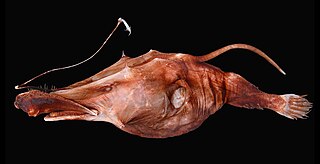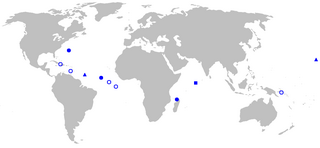
Goosefishes are anglerfishes in the family Lophiidae found in the Arctic, Atlantic, Indian, and Pacific Oceans, where they live on sandy and muddy bottoms of the continental shelf and continental slope, to depths of more than 1,000 m (3,300 ft). Like most other anglerfishes, they have a very large head with a large mouth that bears long, sharp, recurved teeth. Also like other anglerfishes, the first spine of the spinous dorsal fin has been modified as an angling apparatus (illicium) that bears a bulb-like or fleshy lure (esca).

The footballfish form a family, Himantolophidae, of globose, deep-sea anglerfishes found in tropical and subtropical waters of the Atlantic, Indian, and Pacific Ocean. The family contains about 22 species all in a single genus, Himantolophus.

The dreamers are a family, Oneirodidae, of deep-sea anglerfishes in the order Lophiiformes. They are the largest and most diverse group of deep-sea anglerfish, and also the least well known with 16 genera represented by only one, two, or three female specimens. There are sixty-two species within the family, and that contains more females than males. They are found in deep, temperate waters around the world. They are small fish, the largest species only growing to about 20 cm (7.9 in) in total length. The largest female size that is known is about 370-mm and the largest known male is 16.5 mm. Females are dark brown to black all over their entire body, meanwhile males are also dark brown to black, but the nasal area is not pigmented for them. Female dreamers are found in a preservative dark brown to black color externally except for the escal appendages and distal portion of the escal bulb. Males are also the same color, except in their nasal areas.

Haplophryne mollis, the ghostly seadevil or soft leftvent angler, is a species of anglerfish in the family Linophrynidae and is the only species in the genus Haplophryne. It is found in the bathypelagic and mesopelagic zones of tropical and subtropical parts of the world's oceans at depths down to about 2,250 m (7,400 ft).
Bertella idiomorpha is a species of deep-sea anglerfish found in the northern Pacific Ocean. It is the only species in the genus Bertella, in the family Oneirodidae, and can be distinguished from other members of the family by the structure of its hyomandibular bone.

The horned lantern fish or prickly seadevil is a deep-sea anglerfish found worldwide. It is the sole species in the family Centrophrynidae, distinguished from other deep-sea anglerfishes by various characters including four pectoral radials, an anterior spine on the subopercular bone, and a short hyoid (chin) barbel in both sexes.

Spiniphryne duhameli is a species of dreamer known from the central Pacific Ocean. The females of this species grow to a length of 11.7 centimetres (4.6 in) SL. The esca contains a pair of short, slender filaments at the tip, a small, simple appendage without distal filaments on the back, and three pairs of long, slender filaments on the sides. S. duhameli also has more dental teeth than S. gladisfenae.
Spiniphryne gladisfenae, also known as the prickly dreamer, is a species of dreamer. Dreamers are a type of deep sea anglerfish known only from the Atlantic Ocean. Anglerfish are classified by how they lure their prey. Female anglerfish have a piece of dorsal spine that protrudes above their mouth and is luminescent in order to attract prey. The females of the species Spiniphryne gladisfenae can grow to a length of 10.5 centimetres (4.1 in) SL. The esca contains two bulbous appendages on the tip, covered with tiny papillae and with clusters of tiny filaments around the base. There is also a large appendage on the back, divided at the end into three lobes or many filaments. The number of lateral escal filaments varies from none to three. S. gladisfenae also has fewer dental teeth than S. duhameli.

Phyllorhinichthys is a genus of dreamers. Like other oneirodids, they are small, bathypelagic fish with bioluminescent lures. Phyllorhinichthys is unique amongst the deep-sea anglerfish in having a pair of fleshy, leaf-like structures on its snout.
Phyllorhinichthys micractis is a species of dreamer that has been recorded from the Atlantic, Pacific and Indian Oceans. The females of this species grow to a length of 12 centimetres (4.7 in) SL. The illicium is shorter than that of P. balushkini. The esca has two forward appendages at the tip and the rear appendage is much shorter and stouter than that of P. balushkini. The available specimens vary in the number and presence of additional appendages and filaments. The size of the snout flaps are also highly variable.

Tyrannophryne pugnax, the tyrant devil is a species of deep-sea anglerfish in the dreamer family, Oneirodidae. It is the sole member of its genus. Like other oneirodids, T. pugnax is a bathypelagic fish with a bioluminescent lure. It is known only from two adolescent female specimens, one caught in 1928 near Tahiti-Rarotonga, and the other in 1956 northwest of Bikini Atoll.

The Wonderfish (Thaumatichthys) is a genus of deep-sea anglerfish in the family Thaumatichthyidae, with three known species. Its scientific name means "wonder-fish" in Greek; oceanographer Anton Bruun described these fishes as "altogether one of the oddest creatures in the teeming variety of the fish world." In contrast to other anglerfishes, the bioluminescent lure of Thaumatichthys is located inside its cavernous mouth. They are worldwide in distribution and are ambush predators living near the ocean floor.

The Compleat Anglerfish (Lasiognathus) is a genus of deep-sea anglerfish in the family Thaumatichthyidae, with six species known from the Atlantic and Pacific Oceans. Its lure apparatus appears to consist of a fishing rod, a fishing line, bait, and hooks. It is also distinctive for an enormous upper jaw with premaxillaries that can be folded down to enclose the much shorter lower jaw.

The anglerfish are fish of the teleost order Lophiiformes. They are bony fish named for their characteristic mode of predation, in which a modified luminescent fin ray acts as a lure for other fish. The luminescence comes from symbiotic bacteria, which are thought to be acquired from seawater, that dwell in and around the sea.

Black seadevils are small, deepsea lophiiform fishes of the family Melanocetidae. The five known species are all within the genus Melanocetus. They are found in tropical to temperate waters of the Atlantic, Indian, and Pacific Oceans, with one species known only from the Ross Sea.

The humpback anglerfish is a species of black seadevils in the family of Melanocetidae, which means "black whale" in Greek. The species is named after James Yate Johnson, the English naturalist who discovered the first specimen in Madeira in 1863. The common names include anglerfish, viperfish and fangtoothfish.

Rhynchactis is a genus of deep-sea anglerfish in the family Gigantactinidae, containing three species found worldwide at depths greater than 400 m (1,300 ft). Adult female Rhynchactis reach a standard length (SL) of 11–13 cm (4.3–5.1 in) and have a dark-colored, streamlined body and a relatively small head bearing a very long illicium. Unlike almost all other deep-sea anglerfishes, the illicium bears no bioluminescent esca at the tip. The mouth is almost devoid of teeth, and the inside of both jaws are covered by numerous white glands that are unique to this genus.

Linophryne indica, or headlight angler, is a leftvent anglerfish in the family Linophrynidae, found in the bathyal zone of the Pacific Ocean at depths below 1,000 m (3,300 ft). The female is significantly larger than the mature male. A fossil specimen of this species has been found in the Los Angeles Basin dating back to the Late Miocene, some eight million years ago.

Rhycherus filamentosus, commonly known as the tasselled anglerfish, is a species of frogfish endemic to southern Australia in the southwestern Pacific Ocean and southeastern Indian Ocean. It is a well-camouflaged predator and lies in wait on the seabed for unwary prey to approach too close.
Oneirodes carlsbergi is a species of anglerfish in the family Oneirodidae (dreamers). It takes its name from the Carlsberg Foundation, which funds scientific research.













